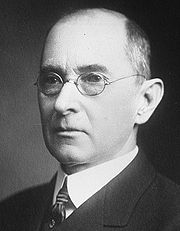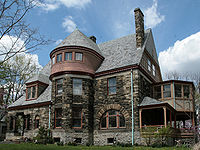
John Uri Lloyd
Encyclopedia

United States
The United States of America is a federal constitutional republic comprising fifty states and a federal district...
pharmacist
Pharmacist
Pharmacists are allied health professionals who practice in pharmacy, the field of health sciences focusing on safe and effective medication use...
influential to the development of pharmacognosy
Pharmacognosy
Pharmacognosy is the study of medicines derived from natural sources. The American Society of Pharmacognosy defines pharmacognosy as "the study of the physical, chemical, biochemical and biological properties of drugs, drug substances or potential drugs or drug substances of natural origin as well...
, ethnobotany
Ethnobotany
Ethnobotany is the scientific study of the relationships that exist between people and plants....
, economic botany
Economic botany
Economic botany can be very broadly defined as a study of relationships between plants and people. Economic botany contributes significantly to anthropology, biology, conservation, botany, and other fields of science...
, and herbalism
Herbalism
Herbalism is a traditional medicinal or folk medicine practice based on the use of plants and plant extracts. Herbalism is also known as botanical medicine, medical herbalism, herbal medicine, herbology, herblore, and phytotherapy...
.
He also wrote novels set in northern Kentucky. His most popular novel was the science fiction or allegorical Etidorhpa, or, the end of the earth: the strange history of a mysterious being and the account of a remarkable journey (1895). First distributed privately, it was later illustrated and printed in eighteen editions. Translated into seven languages, it was widely read in Europe as well as the United States and was extremely popular.
Life and career
John Uri Lloyd was born in upstate New York to teachers Sophia Webster and Nelson Marvin Lloyd. His family relocated to Florence and Petersburg in northern KentuckyKentucky
The Commonwealth of Kentucky is a state located in the East Central United States of America. As classified by the United States Census Bureau, Kentucky is a Southern state, more specifically in the East South Central region. Kentucky is one of four U.S. states constituted as a commonwealth...
, near Cincinnati, Ohio
Cincinnati, Ohio
Cincinnati is a city in the U.S. state of Ohio. Cincinnati is the county seat of Hamilton County. Settled in 1788, the city is located to north of the Ohio River at the Ohio-Kentucky border, near Indiana. The population within city limits is 296,943 according to the 2010 census, making it Ohio's...
in 1853. Lloyd took an apprenticeship with the chemist William J.M. Gordon when he was 14 years old and later apprenticed with George Eger.
His younger brothers Nelson Ashley Lloyd (1851-1926) and Curtis Gates Lloyd
Curtis Gates Lloyd
Curtis Gates Lloyd was an American mycologist known for both his research on the Gasteromycetes, as well as his controversial views on naming conventions in taxonomy. He had a herbarium with over 59,000 fungal specimens, and published over a thousand new species of fungi...
(1859-1926) also became chemists. During 1886 the brothers bought the Merrell and Thorpe Company, renaming it as Lloyd Brothers, Pharmacists, Inc. John Lloyd's innovations include a "cold still" for plant extractions and the first buffered alkaloid (made with hydrous aluminium silicate
Aluminium silicate
Aluminium silicate has the chemical formula 2SiO3. It has a density of 2.8 to 2.9 g/cm³, a vitreous lustre, a refractive index of 1.56, a Mohs hardness of 4.5-7.5 , and can have orthorhombic crystallography...
), called alcresta.
During 1919 Lloyd and his two brothers established trusts to fund the Lloyd Library and Museum
Lloyd Library and Museum
The Lloyd Library and Museum is a collection in Cincinnati, Ohio, USA, covering medical botany, pharmacy, eclectic medicine, and horticulture. It was initially started from the personal collection of the pharmacist John Uri Lloyd in 1864. In 1919, John Uri Lloyd and his two brothers, Nelson Ashley...
. Today it is considered by many to house the finest collections in the world devoted to eclectic medicine
Eclectic medicine
Eclectic medicine was a branch of American medicine which made use of botanical remedies along with other substances and physical therapy practices, popular in the latter half of the 19th and first half of the 20th centuries....
, medical botany and pharmacy. During the 19th and early 20th century, the eclectic medicine
Eclectic medicine
Eclectic medicine was a branch of American medicine which made use of botanical remedies along with other substances and physical therapy practices, popular in the latter half of the 19th and first half of the 20th centuries....
movement was popular, which incorporated the use of medical botany. It founded associated medical schools, including the Eclectic Medical Institute, first located in Worthington in 1833, which moved to Cincinnati, where it had students from 1845-1939.
After Lloyd's death in 1936, S.B. Penick bought the Lloyd Brothers firm in 1938. In 1960 Hoechst AG
Hoechst AG
Hoechst AG was a German chemicals then life-sciences company that became Aventis Deutschland after its merger with France's Rhône-Poulenc S.A. in 1999...
, the German pharmaceutical manufacturer, purchased the operations.
Writings
Lloyd combined his interests by writing a series of local description novels about the northern Kentucky area. His most popular and influential work was the novel EtidorhpaEtidorhpa
Etidorhpa, or, the end of the earth: the strange history of a mysterious being and the account of a remarkable journey is the title of a scientific allegory or science fiction novel by John Uri Lloyd, a pharmacognocist and pharmaceutical manufacturer of Cincinnati, Ohio...
(1895), a scientific allegory that some consider a work of science fiction
Science fiction
Science fiction is a genre of fiction dealing with imaginary but more or less plausible content such as future settings, futuristic science and technology, space travel, aliens, and paranormal abilities...
. It was part of what are called the genre of "hollow earth" novels, based on a journey to the interior of the earth and another world. He first distributed the book privately. When it was printed commercially, illustrations by J. Augustus Knapp were added. It ran to eighteen editions and was translated into seven languages.
Legacy and honors

- The John Uri Lloyd House in Cincinnati was added to the National Register of Historic PlacesNational Register of Historic PlacesThe National Register of Historic Places is the United States government's official list of districts, sites, buildings, structures, and objects deemed worthy of preservation...
in 1973. - The Lloyd Library and Museum, Cincinnati.
See also
- HerbalismHerbalismHerbalism is a traditional medicinal or folk medicine practice based on the use of plants and plant extracts. Herbalism is also known as botanical medicine, medical herbalism, herbal medicine, herbology, herblore, and phytotherapy...
- PharmacognosyPharmacognosyPharmacognosy is the study of medicines derived from natural sources. The American Society of Pharmacognosy defines pharmacognosy as "the study of the physical, chemical, biochemical and biological properties of drugs, drug substances or potential drugs or drug substances of natural origin as well...
- PharmacologyPharmacologyPharmacology is the branch of medicine and biology concerned with the study of drug action. More specifically, it is the study of the interactions that occur between a living organism and chemicals that affect normal or abnormal biochemical function...
- Eclectic medicineEclectic medicineEclectic medicine was a branch of American medicine which made use of botanical remedies along with other substances and physical therapy practices, popular in the latter half of the 19th and first half of the 20th centuries....
- Harvey Wickes FelterHarvey Wickes FelterHarvey Wickes Felter was an eclectic medicine doctor and co-author with John Uri Lloyd of King's American Dispensatory and Felter's Eclectic Materia Medica.-External links:* @ Henriette Kress's Herbal website....
- Michael Moore (herbalist)Michael Moore (herbalist)Michael Moore was a medicinal herbalist, author of several reference works on botanical medicine, and founder of the Southwest School of Botanical Medicine . Before he was an herbalist Michael Moore was a musician and a composer...
- David WinstonDavid WinstonDavid Winston RH is an American herbalist and ethnobotanist. He has been in practice and teaching since 1977 and has written several books on the subject. He works in the Cherokee, Chinese and the Western eclectic herbal traditions...
- Lloyd Library and MuseumLloyd Library and MuseumThe Lloyd Library and Museum is a collection in Cincinnati, Ohio, USA, covering medical botany, pharmacy, eclectic medicine, and horticulture. It was initially started from the personal collection of the pharmacist John Uri Lloyd in 1864. In 1919, John Uri Lloyd and his two brothers, Nelson Ashley...
- King's American DispensatoryKing's American DispensatoryKing's American Dispensatory is a book first published in 1854 that covers the uses of herbs used in American medical practice, especially by those involved in Eclectic medicine which was the botanical school of medicine in the 19th to 20th centuries...
External links
- Lloyd Library and Museum
- King's American Dispensatory @ Henriette's Herbal

